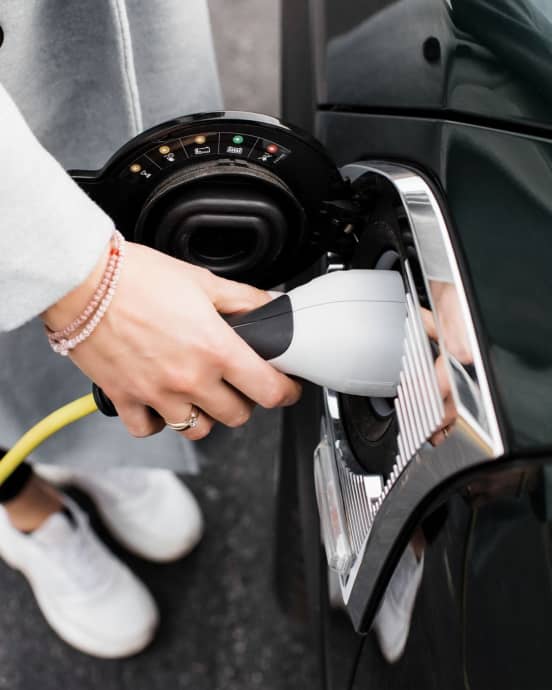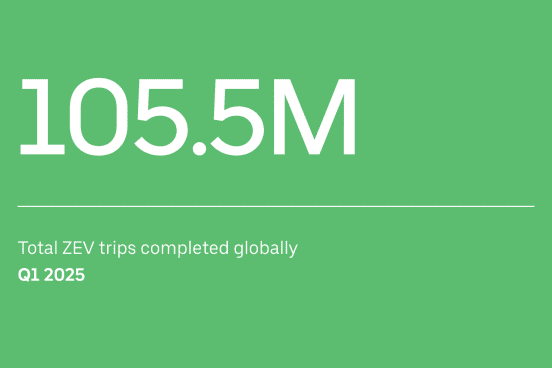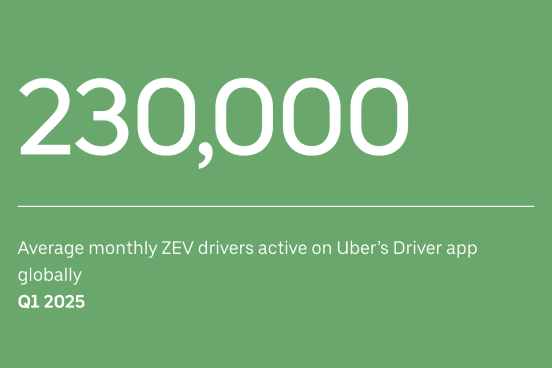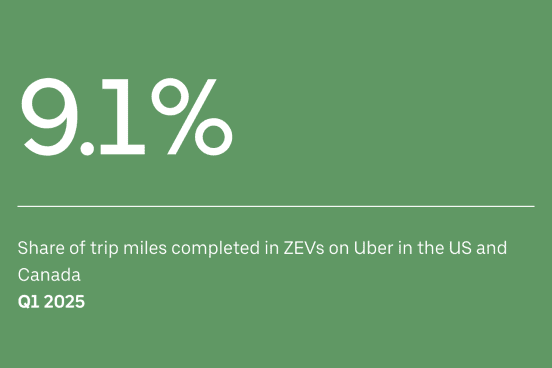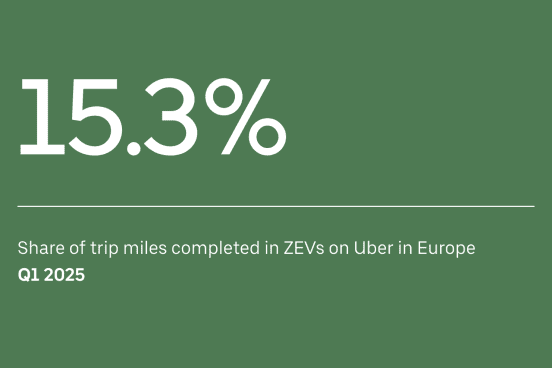Uber’s Electrification Update
"Our ambitious efforts to transition to a zero-emission mobility platform have seen meaningful progress. Today, Uber is the world’s most widely available platform for zero-emission rides, with drivers adopting EVs up to 5 times faster than average motorists in the US, Canada, and Europe."
Rebecca Tinucci, Global Head of Electrification and Sustainability, Uber
Q1 2025 Update: This page includes metrics for trips completed on Uber by internal combustion engine (ICE) vehicles and zero-emission vehicles (ZEVs, such as battery EVs) from the beginning of the first quarter of 2021 to the end of the first quarter of 2025. Note that the scope of this report includes only Uber’s Mobility business (ridesharing).
Tracking our journey to zero emissions
Five years into our ambitious effort to transition to a zero-emission platform, we’ve made meaningful progress. Today, Uber is the world's most widely available platform for zero-emission rides, with drivers adopting EVs (electric vehicles) up to 5 times faster than average motorists in the US, Canada, and Europe.
We’ve invested hundreds of millions of dollars to help interested drivers make the switch to electric through incentives, partnerships, and product enhancements—and it’s paying off. Increasingly, riders are experiencing their first EV on Uber, helping to normalize and accelerate the adoption of electric transport all over the world.
Our data shows that EV progress quickens when government and industry work together to get the economics right. In cities like London, Vancouver, and Amsterdam, where thoughtful policies, industry investment, and strong charging networks align, more than 1 in every 3 miles on Uber are now electric.
Despite this significant progress, major barriers remain to fully achieve our goals. High upfront EV costs, limited charging access, and inconsistent policy support continue to slow adoption. Based on current trends, we cannot meet our remaining mobility and delivery goals for 2025, and our 2030 goals will be out of reach without stronger, coordinated action across government and industry.
As we’ve said from the start: climate is a team sport, and progress depends on collective action. That’s why we’re increasingly prioritizing efforts in cities where public and private investment are aligned.
While many key levers are outside our control, we remain deeply committed to this transition—not just because it’s the right thing to do, but also because it brings direct and strategic business benefits. Thousands of drivers around the world are taking home more money thanks to lower EV operating costs and rider demand for electric vehicles. Riders report higher satisfaction with the EV experience and are increasingly choosing EVs.
And finally, the future is shared, electric, and autonomous—and the coming wave of autonomous (electric) vehicles will create a major tailwind in achieving our sustainability goals.
Our latest update below outlines the progress to date, key insights, and areas of focus for 2025 and beyond.
__
Rebecca Tinucci, Global Head of Electrification and Sustainability, Uber
May 7, 2025
ZEV ড্রাইভার
Globally, more than 230,000 ZEV drivers were active on Uber’s app in Q1 2025. That’s over 60% more than the same period a year earlier.
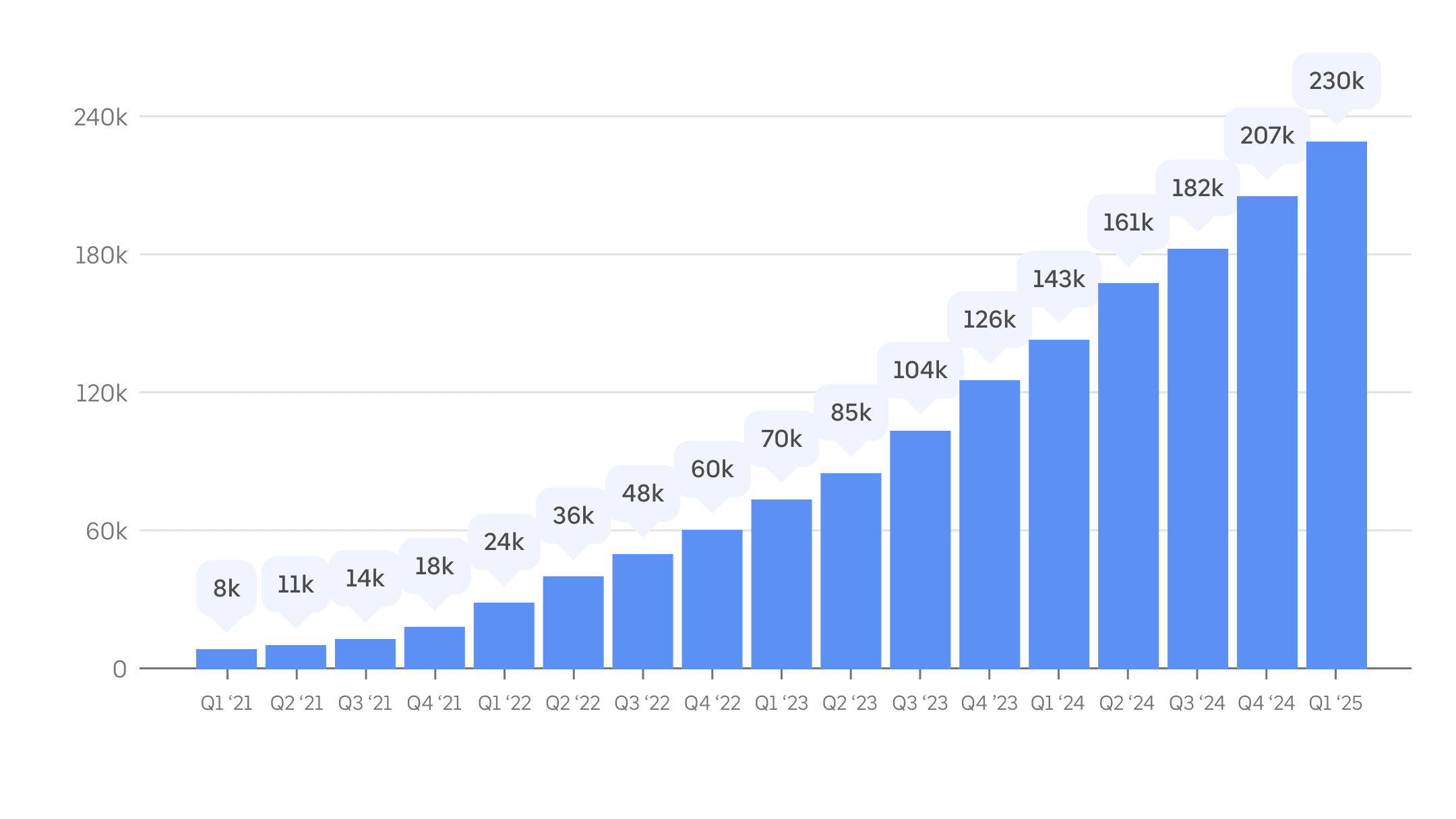
Metric: Average monthly active ZEV drivers on Uber, by quarter, since Q1 2021. Drivers using Uber’s app are counted as active in a given month if they’ve completed at least one trip in that calendar month.
ZEV ট্রিপ
In Q1 2025, ZEV drivers completed over 105 million tailpipe-emissions-free trips using Uber, globally—over 60% more than the number of ZEV trips completed on Uber during the same period a year earlier. That’s more than 13 ZEV trips on Uber every second, on average.
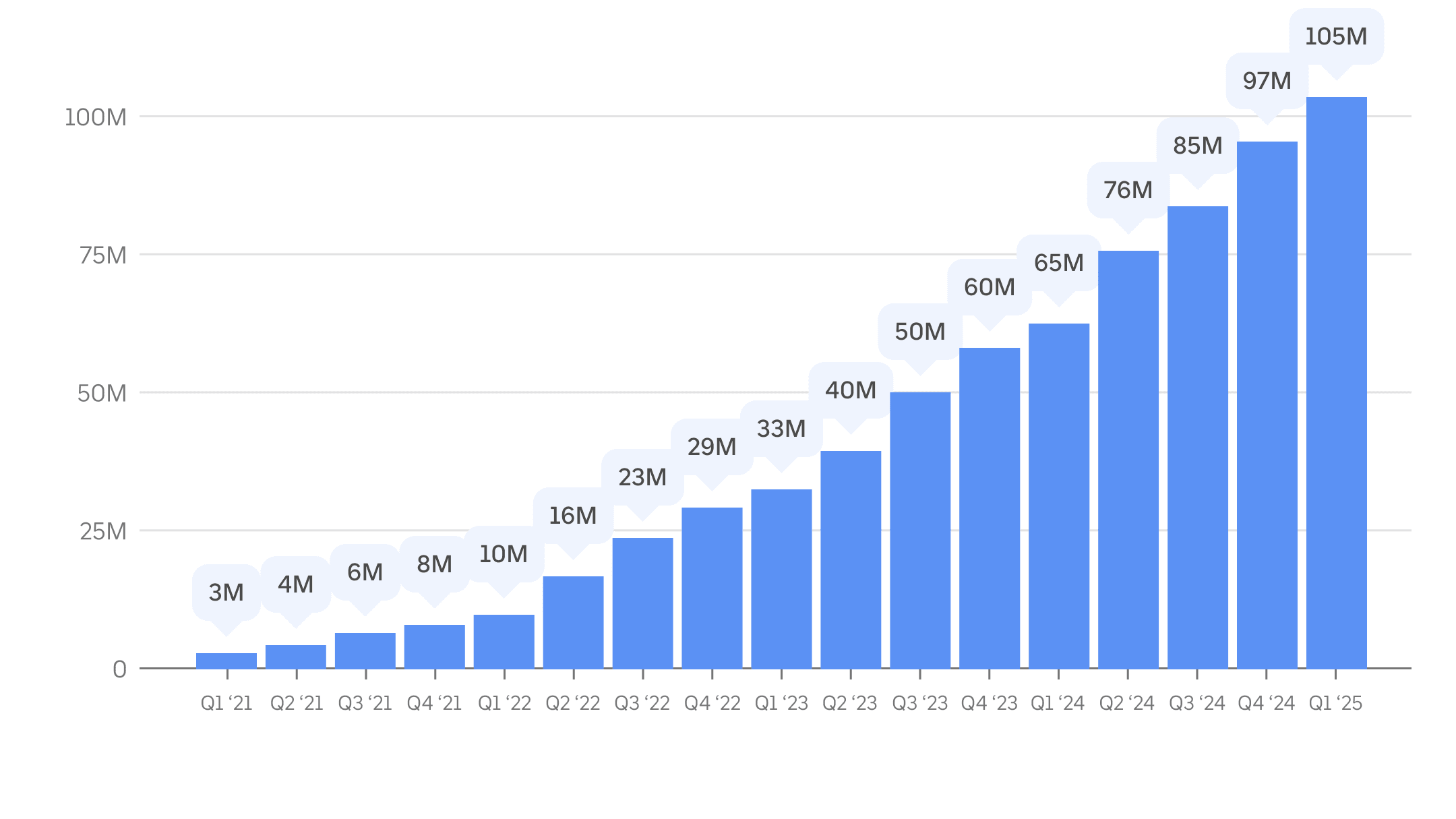
মেট্রিক মেট্রিক: Uber অ্যাপে সাজানো ট্রিপের সংখ্যা এবং 2021 সাল থেকে ত্রৈমাসিক ZEV ড্রাইভারদের দ্বা��রা পূরণ করা হয়েছে।
ZEV গ্রহণ করুন
In Q1 2025, ZEV drivers completed 15.3% of all on-trip miles in Europe and 9.1% of all on-trip miles in Canada and the US—adoption levels many times above drivers in the general public. Figures published in a 2024 BloombergNEF report show that ZEV uptake by Uber drivers in Europe was about 5 times faster than that of typical motorists.
Over the last 4 years, the average annual increase in all-electric on-trip mileage share on Uber in Europe and in the US and Canada was 3.1 and 2.2 percentage points, respectively. The highest and lowest annual increases recorded over that period occurred in the last year: since Q1 2024, ZEV uptake jumped more than 6 percentage points in Europe and just under 1 in the US and Canada.
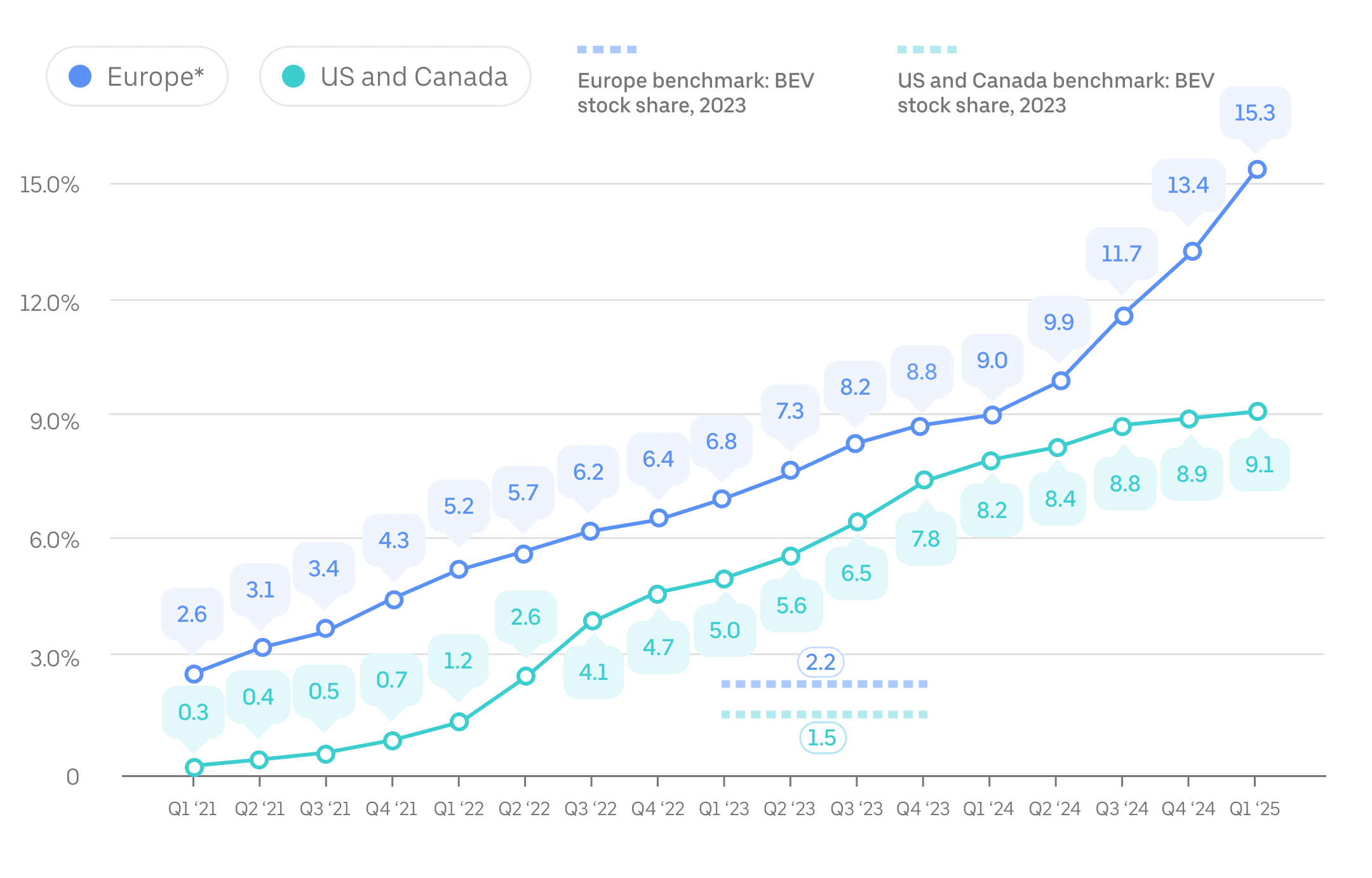
Metric: Share of on-trip miles completed in ZEVs compared with all on-trip miles arranged by the Uber app, by quarter since Q1 2021. Canada, US, and European benchmark data is as of 2023 (the most recently available at the time of this update) and is sourced from the International Energy Agency. “BEV” refers to battery electric vehicles.
যাত্রীর কার্বনের তীব্রতা
In 2024, each mile that a passenger traveled on Uber resulted in an average generation of 197 grams of CO₂ in Europe (or 123 grams of CO₂ per kilometer) and 340 grams of CO₂ in the US and Canada (or 212 grams of CO₂ per kilometer). Compared with 2021, this passenger carbon intensity metric fell nearly 14% in Europe and 6% across the US and Canada.
Passenger carbon intensity in Europe, the US, and Canada increased slightly between 2023 and 2024 due to minor decreases in average passenger occupancy and increases in “deadheading” (vehicle mileage incurred before and on the way to picking up passengers).
Metric: Passenger carbon intensity, or the estimated grams of CO₂ per passenger mile traveled, is an annual efficiency metric used by Uber—and, increasingly, governments and companies around the world. In the case of ridesharing, or any on-demand mobility service, emissions produced by any deadhead miles are factored into the calculation.
For more details about how we calculate passenger carbon intensity, go to our methodology document. Note that significantly lower average fuel economy for vehicles on Uber in Europe versus the US and Canada explains most of the difference in carbon intensity in these 2 geographies. While the composition of vehicles that drivers use on Uber’s app in Europe is more efficient (with a higher proportion of ZEVs and hybrids), more-stringent fuel economy reporting standards in the US also contributes to this discrepancy. In addition, we lack access to sufficient input data to calculate passenger carbon intensity for trips completed in European markets before 2021.
অন্তর্দৃষ্টি এবং গভীরে ডুব দেওয়া
EVs for everyone: balanced adoption of a maturing technology
মেকিং সাসটেইনেবিলিটি বেটার চয়েস (2024)
How to help spark electric mobility across Europe
টেকসই রাউটিং এর মাধ্যমে নির্গমন সাশ্রয় করা (2023)
কেন Uber প্রাইভেট গাড়ির থেকে মৌলিকভাবে আলাদা (2021)
কার্বনের তীব্রতার জন্য গতিশীলতা পরিমাপ করা (2019)
প্রায়শই জিজ্ঞাসিত প্রশ্নাবলী
- What is in Uber’s Electrification Update?
Our Electrification Update provides interested stakeholders with performance-based metrics on carbon-related emissions and electrification for passenger vehicle trips enabled by the Uber app.
- Why are you publishing this update?
Down Small This update, based on real-world use of our mobility platform, helps provide greater transparency of our electrification impact and helps us improve our efforts to support efficiency on our platform.
- What are the key measurements you use in the Electrification Update?
Down Small - How will this update improve emissions reduction and electrification uptake for rides on Uber?
Down Small We have bold ambitions to reduce the passenger carbon intensity of trips and increase the use of zero-emission vehicles on Uber. Measurement and transparency of the progress are important steps along our journey.
- যাত্রীরা কি কম-কার্বন বিকল্প গুলি ব্যবহার না করে Uber- এ ট্রিপ নেয়?
Down Small যারা রাইড খুঁজছেন তাদের জন্য উপলভ্য অনেক পরিবহন বিকল্পগুলির মধ্যে Uber অ্যাপের রাইডগুলি অন্যতম। ট্রিপ পছন্দ অনেকটাই নির্ভর করে স্থানীয় বাজারের বিভিন্ন অবস্থার উপর। আমাদে��র বিশ্লেষণ মার্কিন যুক্তরাষ্ট্রের ন্যাশনাল হাউসহোল্ড ট্র্যাভেল সার্ভে ডেটা দেখায় যে সবচেয়ে টেকসই পরিবহন মোডগুলির (ট্রানজিট, হাঁটা এবং বাইকিং) প্রতি পরিবারে উচ্চতর ব্যবহার রাইড শেয়ারিং এবং অন্যান্য অন-ডিমান্ড সমাধানগুলির উচ্চতর ব্যবহারের সাথে সম্পর্কিত।
- আপনি কি বিশ্বের অন্যান্য দেশ বা অঞ্চলের জন্য একই ডেটা পরিমাপ করবেন?
Down Small Many of the above metrics now cover all passenger trips completed with the Uber app globally. We’re aligned to regular reporting on carbon emissions and other impact areas resulting from trips on Uber.
- With what frequency do you expect to provide Uber’s Electrification Update?
Down Small We update metrics at least annually and may update some metrics more frequently. We’ll release emissions metrics (like passenger carbon intensity) annually, aggregated by calendar year.
- "শূন্য-নির্গমন গাড়ি" বলতে আপনি কী বোঝেন?
Down Small আমরা "শূন্য-নির্গমন যানবাহন" (ZEV) শব্দটি একইভাবে ব্যবহার করি যেভাবে আমরা ক্যালিফোর্নিয়া এয়ার রিসোর্স বোর্ড (CARB) এবং ইউরোপের পরিবহন & পরিবেশ(T&E) এর মতই একইভাবে "শূন্য-নির্গমন গাড়ি" (ZEV) শব্দটি ব্যবহার করি: বিদ্যুতের উৎস থেকে সরাসরি CO2 নির্গমন বা অন্যান্য মানদণ্ডে বায়ু দূষণকারী (যেমন NOx, পার্টিকুলেট ম্যাটার, CO₂ এবং SOx) উৎপন্ন করে না এমন গাড়িকে উল্লেখ করতে। আঞ্চলিক বৈচিত্র্যগুলি পাঠকের বিবেচনার ভিত্তিতে বিবেচনা করা উচিত।
Uber-এর অ্যাপ ব্যবহারকারী ড্রাইভাররা আজ 2 ধরণের ZEV ব্যবহার করেন: ব্যাটারি ইলেকট্রিক গাড়ি (ব্যাটারি EV) এবং মাঝেমধ্যে, হাইড্রোজেন-চালিত ফুয়েল সেল ইলেকট্রিক গাড়ি (FCEVs)।
অবশ্যই, ZEV-তে "শূন্য" বলতে গাড়ির প্রবাদতুল্য "টেইলপাইপ" থেকে কোনও নির্গমন না হওয়াকে বোঝায় এবং অগত্যা সেই সমস্ত নির্গমনকে বোঝায় যা উৎপাদন থেকে গাড়ির নিষ্পত্তি এবং তার শক্তির উৎস হিসাবে বিবেচনা করা যেতে পারে। তবে, সব হিসাব করা হয়েছে, স্বাধীন বিশেষজ্ঞদের জীবনচক্র বিশ্লেষণ দেখান যে আজ নিবন্ধিত গড় মাঝারি আকারের ব্যাটারি EV-এর জীবদ্দশায় নির্গমন এরমধ্যেই তুলনামূলক পেট্রল গাড়ির তুলনায় ইউরোপে 66%–69%, মার্কিন যুক্তরাষ্ট্রে 60%–68%, চীনে 37%–45%, এবং ভারতে 19%–34%।”
- Will you measure impact for your Delivery business?
Down Small Our Electrification Update currently covers electrification and emissions metrics only for our Mobility business (ridesharing). We aim to include our progress on delivery emissions and electrification in future.
On packaging, Uber continues to invest in helping merchants transition to sustainable options. However, as with electrification, progress depends on collective action. We’re prioritizing efforts in cities where public and private investments are aligned. For example, in France over 60% of packaging used on the platform is recyclable, reusable, or compostable, supported by national policy and local incentives.
While progress has been made, based on current trends, we cannot meet all 2025 goals, and our 2030 goals will be out of reach without stronger, coordinated action across government and industry.
While many key levers are outside our control, we remain deeply committed to this transition. To learn more about Uber’s approach to more sustainable packaging with merchants, consult our Uber Eats for Merchants web page.
- Uber কি স্কোপ 1, 2 এবং ৩ নির্গমন প্রকাশ করে এবং যদি তা হয়, তাহলে সেগুলি কোথায় পাওয়া যাবে?
Down Small Uber discloses Scope 1, 2, and 3 emissions to CDP. You can find our most recent score in CDP’s public corporate score search. These emissions estimates have received limited assurance from an independent third party.
সহ এই সাইট এবং সম্পর্কিত জলবায়ু মূল্যায়ন ও পারফরম্যান্স রিপোর্ট ("রিপোর্ট")-এ আমাদের ব্যবসার কাছ থেকে আগামী দিনে কী প্রত্যাশা করা হতে পারে এবং তা কী লক্ষ্য নিয়ে এগোবে সেই সম্পর্কে ভবিষ্যতমুখী বক্তব্য আছে, যার সঙ্গে জড়িয়ে আছে ঝুঁকি এবং অনিশ্চয়তা। প্রকৃত ফলাফল প্রত্যাশিত ফলাফল থেকে বাস্তবে আলাদা হতে পারে। আরও তথ্যের জন্য, অনুগ্রহ করে আমাদের রিপোর্টটি দেখুন।
এই রিপোর্টে প্রকাশিত কিছু ডেটা LRQA থেকে সীমিত আশ্বাস পেয়েছে। LRQA এর যাচাইকরণ স্টেটমেন্টটিএখানে পাওয়া যাবে।
Uber-এর কার্বন অফসেট ব্যবহারের একটি সংক্ষিপ্ত বিবরণ পাওয়া যাবে এখানে।
"এই রিপোর্টে "ড্রাইভার", "কুরিয়ার", "উপার্জন", শূন্য-নির্গমন গাড়ি" এবং "টেকসই প্যাকেজিং"-এর মতো শব্দের ব্যবহার সাধারণ এবং Uber Technologies, Inc-এর সাধারণ ব্যবহারের ক্ষেত্রে এই শব্দগুলি অনুসরণ করা হয়।" শব্দের আঞ্চলিক পরিবর্তনগুলি পাঠকের বিবেচনার ভিত্তিতে বিবেচনা করা উচিত।
সম্পর্কিত
